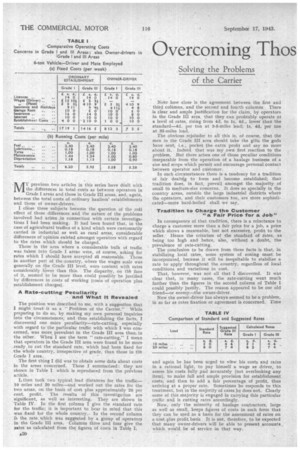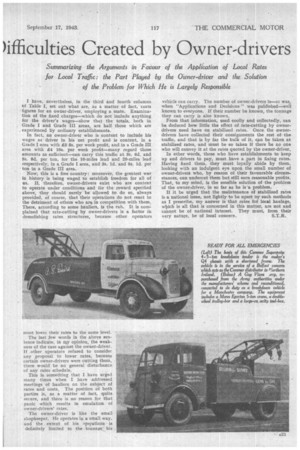Overcoming Thos hfficulties Created by Owner-drivers
Page 22

Page 23

If you've noticed an error in this article please click here to report it so we can fix it.
Solving the Problems of the Carrier Summarizing the Arguments in Favour of the Application of Local Rates for Local Traffic: the Part Played by the Owner-driver and the Solution of the Problem for Which He is Largely Responsible
.MY previous two articles in this series have dealt with the differences in total costs as between operators in Grade I areas and those in Grade III areas, and, again, between the total costs of ordinary hauliers' establishments and those of owner-drivers.
I chose these subjects because the question of the real effect of those differences and the nature of the problems involved had arisen _in connection with certain investigations I had been making. It had been found that, in the case of agricultural traffics of a kind which were customarily carried in industrial as well as rural areas, considerable differences of opinion existed amongst operators with regard to the rates which should be charged. , Those in the area where a considerable bulk of traffic was taken into Grade I areas were, of course, asking for rates which I should have accepted at reasonable. Those in another part of the-country, where the wages scale was generally on the Grade III level, were content with rates considerably lower than this. The disparity, on tht face of it, seemed to be more than could possibly be justified by differences in costs of Working (costs of operation plus establishment charges).
A Rate-cutting Peculiarity • and What It Revealed The position was described to me, with a suggestion that I might treat it as a " Problem of the Carrier." While preparing to do so, by making my own personal inquiries into the circumstances; and thus establishing the facts, I discovered one more peculiarity—rate-cutting, especially with regard to the particular traffic with which I was concerned, was more prevalent in the Grade III area than, in the other. When I use the term " rate-cutting," I mean that operators in the Grade III area were found to be more . ready. to cut the standard rate, which had been fixed for :the whole country, irrespective of grade, than those in the Grade I area.
The first thing I did was to obtain some data about costs in the areas concerned. These I summarized ; they are shown in Table I. which is reproduced from the previous article.
I. then took two typical lead distances for the traffic10 miles and 20 miles—and worked out the rates for the two areas, on the basis of cost plus approximately 20 per cent. profit. The results of this investigation are significant, as well as interesting. They are shown in Table IV. In the first column I give the standard rate for the traffic; it is important to bear in mind that this was fixed for the whole country. In the second column is the rate. which was suggested by a group of operators in the Grade III are,a. Columns three and four give the rates. as calculated from -the figures of costs in Table I.
Note how close is the agreement between the first and third columns, and the second and fourth columns There is clear and ample justification for the claim, by operators In. the Grade III area, that they can profitably operate at a level of rates, rising from 4d. to Is. 4d., lower than the standard-4d. per ton at 3-5-miles lead; Is. 4d, per ton at 35-miles lead.
The obvious rejoinder to all this is, of course, that the men in the Grade III area should take the gifts the gods have sent, i.e., pocket the extra profit and say no more about it. Indeed that was my own first reaction to the problem. But there arises one of those peculiar conditions inseparable from the operation of a haulage business of a size and scope which permit and encourage personal contact between operator and customer.
In such circumstances there is a tendency for a tradition of fair dealirig to• form and become established; that tradition does, in fact, prevail amongst the majority of small to medium-size concerns. It does so specially in the country areas, outside the large industrial districts where the operators, and their customers too, are More sophisticated—more hard-boiled shall we say.
Tradition to Charge the Customer "a Fair Price for a Job" In consequence of that tradition, there is a reluctance to charge a customer snore than a fair price for a job, a price which shows a reasonable, but not excessive, profit to the seller. Hence the criticism of the standard of rates, as being too high and hence, also, without a doubt, the prevalence of rate-cutting. The conclusion to be drawn from these facts is that, in stabilizing local rates, some system of zoning must be incorporated, because it will be inequitable to stabilize a rate to apply throughout the country, regardless of local conditions and variations in cost.
That, however, was not all that I discovered. It was clear that, in many cases, the rate-cutting went much farther than the figures in the second column of Table I could possibly justify. The reason appeared to be our Old friend—or enernythe owner-driver. Now the owner-driver has always seemed to be a problem, in so far as rates fixation or agreement is concerned. Time and again he has been urged to view his costs and rates in a rational light, to pay himself a wage as driver, to assess his costs fully nd accurately (not overlooking any item), to make full and ample provision for establishment costs; and then to add a fair percentage of profit, thus arriving at a proper rate. Sometimes he responds to this treatment, but in the majority of cases he does not. Clearly some of this majority is engaged in carrying this particular traffic and is cutting rates accordingly.
Now, only the minority of haulage contractors, large. as well as small, keeps figures of costs in such form that they can be used as a basis for the assessment of rates on a cost plus profit basis It is not, therefore, to be expected that many owner-drivers will be able to present accounts which would be of service in that way. I have, nevertheless, in the third and fourth columns of Table I, set out what are, as a matter of fact, costs figures for an owner-driver, employing a mate. Examination of the fixed charges—which do not include anything for the driver's wages—show that the totals, both in Grade I and Grade III areas, are half those which are experienced by ordinary establishments. In fact, an owner-driver who is content to include his wages as driver in his net profit and is content, in a Grade I area with £5 5s. per week profit, and in a Grade III area with £4 10s. per week profit—many regard those amounts as sufficient—can carry this traffic at 35. 43d. and 5s. 8d. per ton, for the 10-miles lead and 20-miles lead respectively, in a Grade I area, and 3s. 1d. and 5s. Id, per ton in a Grade III area.
Now, this is a free country: moreover, the greatest war in history is being waged to establish freedom for all of us. If, therefore, owner-drivers exist who are content to operate under conditions and fOr the reward specified above, they should surely' be allowed to do so, always provided, of course, that their operations do not react to the detriment of others who are, in competition with them. There, according to some hauliers, is the rub. It is conil plainer] that rate-cutting by owner-drivers is a factor in demolishing rates structures, because other operators must lowei their rates to the same level.
The last few words in the above sentence indicate, in ray opinion, the weakness of the case against the owner-drivee. If other operators refused. to consider any proposal to lower rates, because certain owner-drivers were cutting them, there would be no general disturbance of any rates schedule. This is something that I have urged many times when I have • addressed meetings of hauliers on the subject of rates and costs. The position of both parties is, as a matter of fact, quite secure, and there is no reason for that. panic which results in emulation of owner-drivers' rates.
The owner-driver is like the small shopkeeper. He operates in a small way, and the extent of his operations • is definitely limited to the tonnage his vehicle can carry. The number of owner-drivers Is—or was, when "Applications and Decisions" was published—well known to everyone. If their number be known, the tonnage they can carry is also known.
From that information, used coolly and collectedly, can be deduced how little the effect of rate-cutting by ownerdrivers need have on stabilized rates. Once the ownerdrivers have collected their consignments the rest of the traffic, and that is by far the bulk of it, can be taken at stabilized rates, and must be so taken if there be no one who will convey it at the rates quoted by the owner-driver, In other words, those who have establishments to keep up and drivers to pay, must have a part in fixing rates. Having fixed them, they must loyally abide by them, looking with an indulgent eye upon the small number of owner-drivers who, by reason of their favourable circumstances, can undercut them but stilt earn reasonable profits. That, to my mind, is the sensible solution of the problem of the owner-driver, in so far as he is'a problem.
If it be urged that the maintenance of stabilized rates is a national issue, not lightly to be upset by such methods as I prescribe, my answer is that rates for local haulage, which is all that is concerned in this matter, are not and cannot be of national interest. They must, from their very nature, be of local concern. S.T.R.




















































